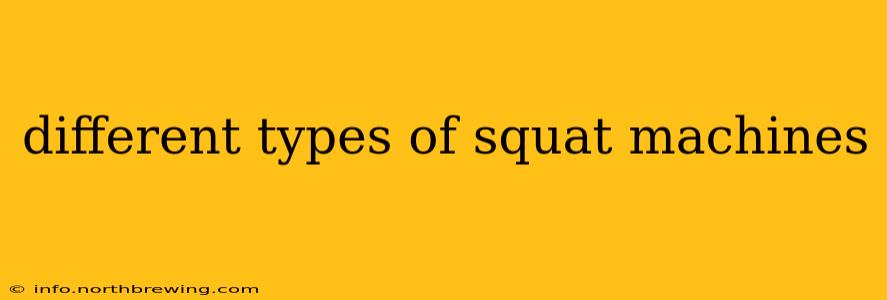Squats are a cornerstone of any effective strength training program, building lower body strength, power, and overall fitness. However, free weight squats can be challenging for beginners, those with pre-existing injuries, or individuals seeking a more controlled movement. This is where squat machines come in. Offering variations in support and resistance, squat machines cater to diverse fitness levels and goals. This guide explores the different types of squat machines available, highlighting their features and benefits.
What are the Different Types of Squat Machines?
Several squat machine variations exist, each offering unique advantages:
1. Hack Squat Machines
How they work: In a hack squat machine, you stand with your back against a vertical pad, facing the weight stack. Your feet are positioned on a platform, and you perform squats by pushing the platform away from you.
Benefits: The hack squat machine offers excellent support for your back, reducing strain compared to free weight squats. It allows for a greater range of motion and can emphasize the quads more effectively than some other squat variations. They're generally easier on the knees too.
Variations: Some hack squat machines offer adjustable footplates, allowing for different foot positions and targeting specific muscle groups.
2. Smith Machine Squats
How they work: The Smith machine is a barbell held in a guided vertical track. This limits the barbell's movement to a single plane.
Benefits: The Smith machine provides stability and security, particularly beneficial for beginners. It can aid in proper form, assisting with maintaining upright posture and consistent depth during the squat.
Drawbacks: The fixed path of movement can limit natural body mechanics and potentially overemphasize certain muscles while neglecting others.
3. Leg Press Machines
How they work: The leg press machine involves sitting and pushing a weighted platform away from your body using your legs.
Benefits: Leg presses are excellent for building overall leg strength and muscle mass. They allow you to handle heavier weight than free weight squats, making them useful for hypertrophy. The seated position offers a degree of back support.
Variations: Leg press machines vary in the angle of the platform (vertical, horizontal, or angled), affecting the emphasis on different muscle groups.
4. Iso-Lateral Squat Machines
How they work: Iso-lateral machines provide independent movement for each leg. This helps correct muscular imbalances and improves unilateral strength.
Benefits: Iso-lateral squats allow you to address weaknesses in individual legs, promoting better balance and overall functional strength. They can be particularly beneficial for rehabilitation or injury prevention.
5. Assisted Squat Machines
How they work: These machines offer assistance during the concentric (lifting) phase of the squat, reducing the weight you lift, making it easier to perform the movement and improve technique.
Benefits: They are ideal for beginners or individuals returning from injury, as they allow for proper form development while building strength gradually.
What are the benefits of using squat machines?
H2: What are the benefits of using squat machines?
Squat machines offer several advantages:
- Reduced Risk of Injury: The guided movement and support offered by many machines lessen the risk of improper form and related injuries.
- Improved Technique: Machines can help develop proper squatting technique before progressing to free weights.
- Progressive Overload: Machines allow for easy adjustments in weight, enabling progressive overload and consistent strength gains.
- Accessibility: Machines are accessible to individuals with varying fitness levels and physical limitations.
- Muscle Isolation: Some machines, like iso-lateral machines, allow for better muscle isolation and address muscle imbalances.
Which Squat Machine is Right for Me?
The best squat machine for you depends on your individual fitness level, goals, and any physical limitations. Beginners might benefit from assisted or Smith machines, while experienced lifters may prefer hack squats or iso-lateral machines for greater challenge and muscle development. Consult with a qualified fitness professional to determine which machine best suits your needs.
Are Squat Machines Better Than Free Weights?
H2: Are Squat Machines Better Than Free Weights?
There's no single "better" option; squat machines and free weights each offer distinct advantages. Free weights require more balance and coordination, improving overall stability and functional strength. Squat machines prioritize safety and control, making them suitable for various fitness levels. The ideal approach may involve incorporating both into a well-rounded training program.
How do I choose the right weight on a squat machine?
H2: How do I choose the right weight on a squat machine?
Start with a weight that allows you to complete the desired number of repetitions with good form. If you struggle to maintain proper form or can't complete the set, decrease the weight. Gradually increase the weight as you get stronger. Remember to prioritize good form over heavy weight.
This comprehensive guide provides an overview of the diverse world of squat machines. Remember to always prioritize proper form and consult with a qualified fitness professional before starting any new workout routine.
